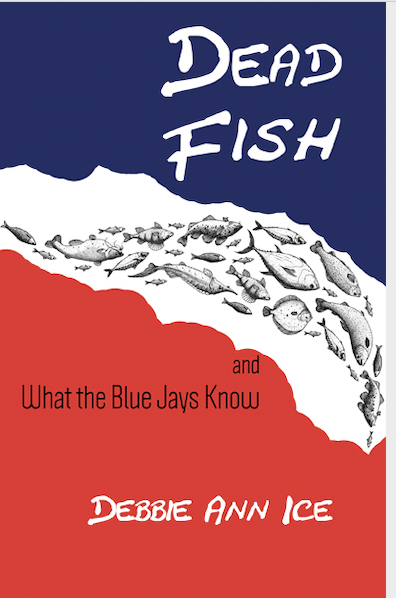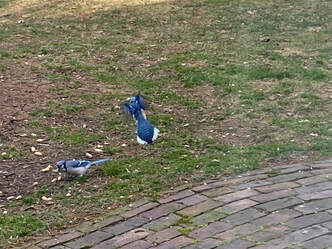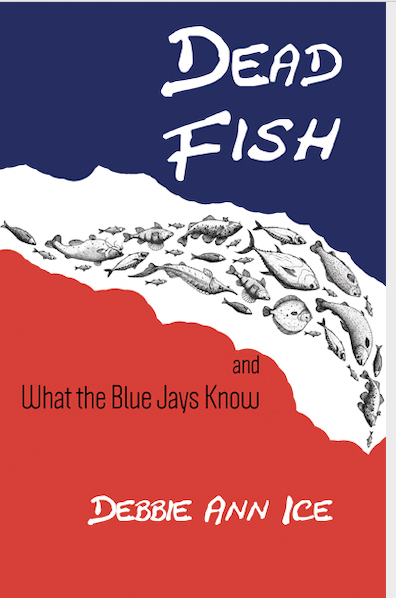|
Many of us live in houses squeezed in between infrastructure and woodlands. Dropped upon small plots of land after we mow down most trees-- the survivors extending their roots underneath gardens and shrubbery, desperately pilfering water and nutrients. Mammals skitter down avenues, hide under our shrubbery, nest in tunnels under our lawns. Birds create societies above us as we walk by, busy with our lives, hardly knowing who they are. Invisible neighbors.
Oh, sure, when our life slows down, some of us notice. Maybe we toss a peanut to a squirrel. We put up feeders for birds-- some of us fill them daily, others only when bored. The retired population of humans who have lots of time purchase digital cameras and post their pictures on birder sites. This serves as proof of their observations. They particularly like posting colorful and rare breeds. I wandered around a Bahama island once with an experienced birder. I didn’t see any unusual birds, but I discovered some interesting details about a few species. But, for the most part, I learned about bird watchers. The birder guide was a trim, fit woman, dressed in khaki pants and a collared shirt. She spoke with a charming British accent and was probably in her late sixties. She had this matter-of-fact, clipped way of conversing. Frank and literal. Although, when she asked a question, a slight twinkle in her eye told me that deep inside her mind lived a funny observation her proper British personality refused to let out. She asked why I had no camera. I said I had a good memory. She asked why I had no checklist. I raised my brows. “Most come with a camera and checklist. Do you not check off birds?” “Most” referred to Americans. “They like to check off all the birds they’ve seen. For those sites.” I said I didn’t see the point of checking off a bird. I wanted to watch them. I asked several questions about behavior and although she knew quite a lot, it was apparent she rarely talked about behavior, because all she did was take bird watchers to birds. And in her experience, American bird watchers always had cameras and check lists. She had neither but did have a bird caller app on her iPhone, which she used it to find birds. She asked if I had a bird caller app. “I just call them myself. I call the chickadees all the time. They always come to me.” And they do. Every year when we begin spring feeding, I call them, at least one immediately arrives. “Oh. Let me hear your call.” She turned and looked at me with her poker face, ready to judge my mimicking skills. “Where’s my chickadee. Where’s my chickadee. Where’s my chickadee. Where’s my chickadee” I used my sing-song voice. “That’s your call?” “Don’t judge. They come. I force them to learn my language.” For the first time she laughed out loud. “You’re unusual,” she said. “You’re also thinner than most of them who like to watch birds. They all wear those shorts and tend to fill them out quite well.” I was wearing jeans. We got along very well. It’s was a good experience, being a “them.” I don’t think everyone, or “Americans,” simply take pictures of birds and check them off. I believe there are some, who, after spending way too much time staring at birds, become curious. They google the bird, educate themselves. Nesting habits, song identification, migration patterns. Picture, Check list, google. That’s birding. But I think there’s an even smaller population of us humans who are wonderers, like me. People who’re not satisfied with information provided by the ornithologists. People who wonder if there’s more. Do animals love? Is there interspecies cooperation? And, importantly, are birds, like us, individuals with distinct personality characteristics? Do we only understand animals through stereotypes because behaviorists generalize? So, I stare when I can. I take pictures when I think of it. I never have a checklist. I’ve noticed birds stare at us. Of course, they do! They fly above us all day. Sure, they’re busy. Nests, eggs, chicks, food to find. But beneath them when en route to that nest or tree is a complex network of human activity. Up there, at a distance, our activities are profoundly more understandable than their activities studied from our myopic, immersed positions. Distance from earth allows a certain context. Deep understanding can only come with context. They know this. They know they understand me more than I understand them. Me, anchored and myopic, trying to figure out my snap shot of their transient life. Ha ha, they laugh. Go ahead and fill yourself with knowledge, the crows and blue jays say. (Corvids are sarcastic). I’ve seen a father finch on the roof tolerating his very annoying fledgling. The fledgling follows his dad from roof to limb to roof. The dad has no seed, nothing. He tries to ignore the juvenile, who is bigger than him, too big to be begging. The spoiled juvenile eventually becomes hysterical. The dad finch stares at his offspring, as we all do when we’ve heard the tantrum too long. We know this look, this exhausted, numbed, hopeless parent look. But this time, suddenly, a male house sparrow appears before the dad finch. The sparrow spits a seed at the dad finch’s talons. The dad finch picks up the seed with his beak and jams it into the baby’s mouth. Peace. Thank you, sparrow. Is this the avian version of It Takes a Village? Is there more of a community than we realize? All the behavior researchers concentrate on intraspecies for their data collection. What about interspecies? And then there are the blue jays. Oh God, the blue jays. The story of the blue jays would take a several posts. Let’s just say, the blue jays pay attention. They get what’s going on and they learn. I’ve been wondering if they are also empathetic. I don’t know, but here’s a story. First, I have to admit something. I like squirrels. I’ve even befriended a tailless squirrel (may she rest in peace. A hawk did not befriend her). I sometimes hold out peanuts to see which squirrel is the bravest. (Always the youngest. And usually the bravest are males because they have no family obligations. No nesting responsibilities. Nothing. They eat and have sex. Period. Females? Do everything!) I’m sure the blue jays find the squirrels annoying. The pesky tree loving animals snatch peanuts and seeds put out for the jays, leap upon the bird feeder, and sometimes steal eggs from nests. They’re stubborn, athletic and sassy. Of course, I like them! But you’d think blue jays wouldn’t appreciate these tree creatures. So, one day I was working in my study and heard screams of jays. Not just a few. Not even a dozen. I heard dozens and dozens of screaming jays. Two of them were actually perched on a limb right by my window screaming right at me. I figured there was a hawk in the back yard who was after a blue jay’s offspring. It was fall and nesting was over but there were still naïve juvenile blue jays vulnerable to predators. The adults were always screaming at predators after the kids. I opened the back door to a very large red-tailed hawk standing in the yard staring at the empty bird feeder. The enormous bird was surrounded by dozens of screaming blue jays in the trees, on my roof, on the backs of patio chairs. Blue jays everywhere, all screaming down at this one hungry hawk. But what was it after? I clapped my hands and followed its flight out of my yard, over the contiguous woods and beyond, it’s retreating wingspan fading into a teeny mustache. When I returned, I searched the area, expecting to find a dead bird. But nothing. I heard what sounded like a dog whimpering. The whimpering grew louder and louder, but there was no dog. Then I realized these dog-like sounds were coming from the squirrel protector cylinder covering a portion of my feeder stand. I tapped the cylinder and a squirrel plopped to the ground and scurried off to the nearest tree, where it stopped, turned and acknowledged me. The squirrel had escaped the hawk only to find itself trapped inside the cylinder, hanging onto the pole for dear life. The blue jays knew it was only a matter of time before the prey would have to let go and fall into the talons of the hungry and patient predator. All these blue jays, dozens of them, screeched and screeched to get my attention so I would save this one squirrel. Why? Because the yard is a village and It Takes a Village? Because they knew I liked and fed squirrels? Or simply because the hawk is their number one nemesis, and they would scream at anything it did? I don’t know. And that’s the point. We don’t know. There is so much we don’t know. And what we particularly don’t know is how we enter into their own ecosystem understanding? Just how do birds see us? Some humans befriend them, others kill them, all humans directly or indirectly destroy their home—the planet. Which is why my next novel, set in the future in an altered country and dying ecosystem, explores the perspective of blue jays. It’s titled DEAD FISH and What the Blue Jays know. My blog will turn to birds, animal-- what others have written about them, what I’ve seen, and where we’re going.
0 Comments
My next novel: DEAD FISH .... and What the Blue Jays Know. I post the synopsis below. Going forward, I will be writing about birds, particularly blue jays, but also other passerines. Oh and of course ducks. Always ducks! Maybe a bit about Turkeys. And squirrels. Baby squirrels. And rabbits. Baby rabbits. I will post pictures etc. My posts will be about our invisible neighbors who depend upon our environment. I may discuss how a loss of liberal democracy ties into the loss of planet health; how environmental disaster is usually shoved onto the backs of the poor, reducing it's impact upon the wealthy and thus allowing environmental tragedy to be invisible to those who make a difference. Invisible and normalized. Here's the synopsis of my novel, which has a sassy, funny veneer, covering a very sad story.
It’s 20??— a changed yet still complacent America-- and Lorraine Mulderon is mad. She’s mad that dying fish litter the shores of her small Connecticut coastal town. She’s mad other birds seem to be dying, possibly indirectly related to fish deaths. She’s still mad about a wave of crow deaths over a decade ago. Oh, and Lorraine is also mad about small local irritants--four-way stop signs, rude “flocks” of bikers clogging up roadways, water wasted on lawns, too much alcohol consumption. But, mostly, Lorraine is mad at the lack of madness. Lorraine writes letters, contacts agencies that no longer employ people, only manage voice mails. She types discursive comments on blogs and web sites. She makes speeches. She phones lazy, and now corrupt, legislators. She is ignored. What has happened to passion? What has happened to our country? And, now, what has happened to Lorraine? Lorraine disappears after a large New York protest march. Her daughter, Haley, is desperate to find her, and ultimately writes a letter to Lorraine for publication, hoping her mother will read it and return. Haley also hopes the world will read it and understand her mother’s story. It’s a story not only about anger, but also about grief; a conflicted and impulsive heart that leads to mistakes; a relationship with a close friend who’s also angry and grieving yet channels anger into action; a complicated, intense bond between a mother and daughter. And, finally, it’s a story about our country’s greatest sin—the normalization of tragedy. Haley is confident she knows her mother better than anyone and therefore can author it. But there are blanks of time where Haley must make assumptions. Perhaps Lorraine’s favorite birds--blue jays—can fill in these blanks. They know a few things about Lorraine. Actually, a bird’s eye view reveals certain truths too difficult for all of us immersed, anchored and egocentric humans to understand. So, we’re grateful the blue jays have dictated memos, interspersed throughout the novel, dropping hints about what is actually going on with Lorraine and all of us. |
AuthorI like to write about people, animals, dogs. I enjoy ideas, good books about ideas, funny books about ideas, funny people who have ideas, advocates for people who don't have voices to express their ideas, and animals who have ideas we can't understand. Archives
November 2021
Categories |



 RSS Feed
RSS Feed